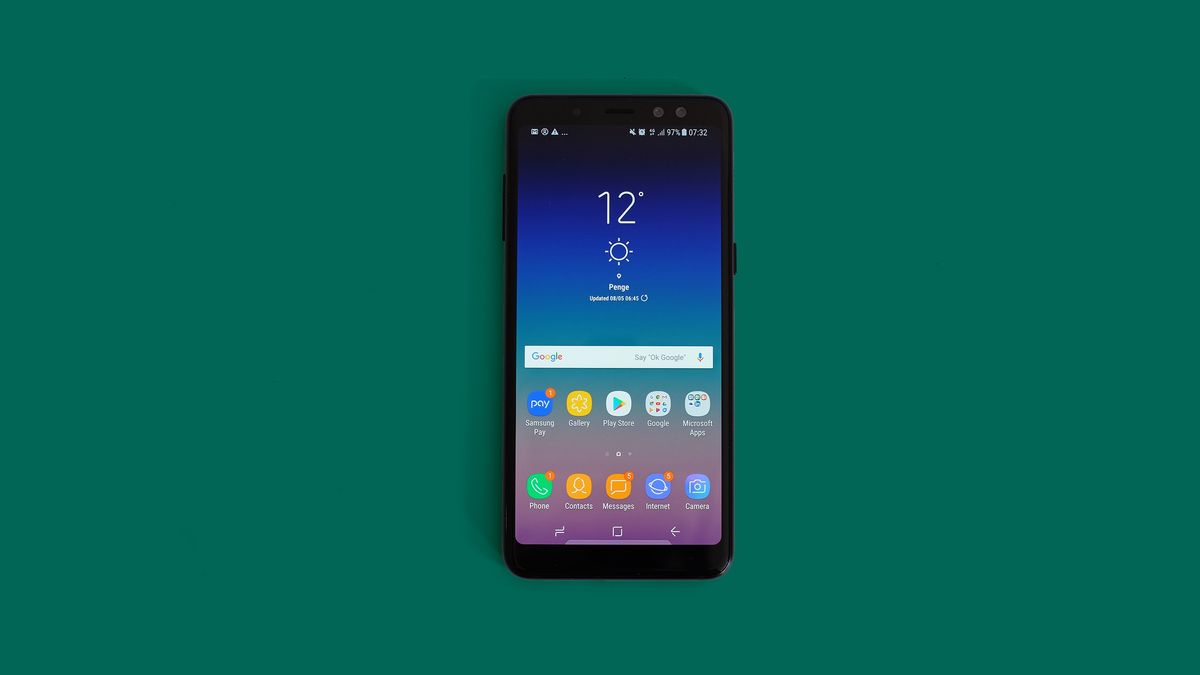TechRadar Verdict
The Samsung Galaxy A8 is a slight step down from the Galaxy S9 - or even the Galaxy S8 - in just about every way, but it still delivers many of the core features offered by the flagships. You can get more for your money elsewhere, but if you're set on Samsung there's little to complain about here.
Pros
- +
Super-vivid OLED screen
- +
Quality build
- +
Excellent water resistance
Cons
- -
Low light photos could be better
- -
No 4K video recording
- -
You’ll find better value elsewhere
Why you can trust TechRadar
Samsung’s A-series phones are for people who can’t, or don’t want to, pay the high price of a top-end S-series model like the Samsung Galaxy S9.
The Samsung Galaxy A8 is one of the higher-end A phones, though. It costs $479 (£449, $AU609). It is not cheap but is still a lot more affordable than the S9: mission success.
This is a solid phone all-round. However, if you’re not set on owning a Samsung, you’ll find more competitive mobiles from companies like OnePlus, Honor and Huawei.
It’s also worth considering an older Samsung. As progress in phones has slowed down in some key areas, the Samsung Galaxy S8 is significantly better in just about every way. And so is the Samsung Galaxy S7, if you don’t mind its rapidly aging 16:9 display shape. Still, there's a lot to like here.
Key features
- Dual-lens front-facing camera
- Bright, colorful display
You might end up with a Galaxy A8 if you decide you want a Samsung, one released in the last year, but don’t want to spend Galaxy S9 money.
Each part of the phone is a little worse, or a little more basic, than the Galaxy S9. Its chipset is less powerful, the frame less curvy, the camera less versatile and the screen is less sharp.
The most important question is whether you’ll notice that much. The Galaxy A8 may not match up to the S9 on paper, but for many the perceptible difference won’t stack up to the difference in price. This is still a great phone.
What do we notice the most? The speaker is much less powerful, and less bassy, the camera is much worse at night and the design doesn’t have anything like the impact of Samsung’s best. Its entry-level spec also only has 32GB of storage, which is fairly poor considering the price.
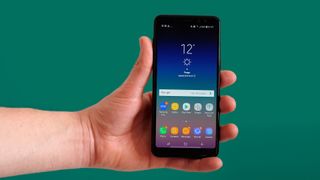
Elements you’re less likely to notice so clearly are the less punchy Exynos 7885 octa-core chipset and lower screen resolution. The Galaxy A8’s display is 'only' 1080p, but still looks sharp, bright and colorful.
Does it have anything the Galaxy S9 lacks? Yes, actually. It has dual front cameras, which let you create images with background blur for a more dramatic selfie look.
Design
- A glass back and metal frame
- Water-resistant
- A plain appearance
The Samsung Galaxy A8 is a mid-range phone, the kind that could easily have been a top-end model were it released a year or so earlier. However, as usual Samsung has made its A-series phones slightly more ordinary-looking to avoid stepping on the S-series’ toes too much.
Its basics are the same, though. The Samsung Galaxy A8 has a glass back, a glass front, and a band of metal around the sides.
So how is it different to a Galaxy S9? That phone’s glass is curved on the front and back. The Galaxy A8's back is curved, if slightly less so than the Galaxy S9’s, and the front is just '2.5D' glass. Some people describe this as curved, but it’s really just rounded-off at the edge.
There’s also a little bit more blank space above and below the display, and the finish is plain. It comes in black, grey, blue and gold, and these colors are flat, without the light-reactive layer used by some other phones. Even the Moto G6, at half the price, reacts a little to light. This is a real no-nonsense design.
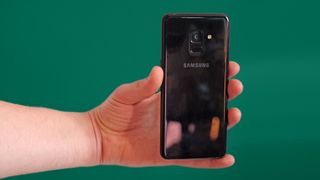
However, the Samsung Galaxy A8 is water-resistant to IP68, a feature not seen in cheaper mid-range phones and even some around the same price. This spec means it can withstand being submerged at a depth of 1.5 meters for 30 minutes. But you still can’t take it swimming.
The Samsung Galaxy A8 has a fingerprint scanner on its back. While we’re very happy with its reliability, it is not the fastest around. Taking just under a second to get you to your home screen, its speed is actually closer to the Moto G6’s than the Huawei P20 Pro’s. But, yes, we are quibbling about a fraction of a second’s difference here.
Storage is another just-okay part. The entry-level Samsung Galaxy A8 has 32GB of storage, and for $479 or £449 that does not seem terribly generous. There is, however, a microSD slot in one of the SIM trays.
In an unusual design move you get two separate trays here. One on the side holds your main SIM, the other up top a second 2G/3G SIM and a memory card slot.
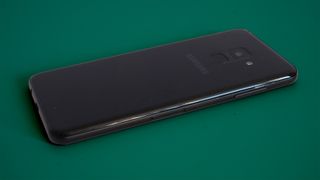
Why split them up? It seems odd to us too, but is likely where Samsung’s engineers found enough space. It also means you can swap memory cards without losing phone signal, which could be useful to those pathologically afraid of missing phone calls.
The Samsung Galaxy A8 is not a phone that screams excitement, lacking the design edge of the Galaxy S9. However, when you break down its parts its build quality is actually comparable.
It’s also a friendly size. The Samsung Galaxy A8 has a 5.6-inch screen but as it has an extra-tall 18.5:9 shape, the phone doesn’t end up too wide.
There’s a headphones jack on the bottom too, a feature missing from quite a lot of high-end phones at this point.
Screen
- A vivid Super AMOLED display
- 5.6-inch 1080 x 2220 screen
The Samsung Galaxy A8 is a reminder of the power of OLED displays. Using its default setting the 5.6-inch screen is incredibly color-saturated. It’s the kind of vividness most LCD screens just can’t recreate.
Of course, not everyone likes this style. It’s the equivalent of a sugary, syrupy drink. You can alter it, though.
Other color modes in the Samsung Galaxy A8’s settings menu make the screen look much more restrained, or well-saturated but not to the cartoonish level of the standard 'Adaptive display'. The other modes are called AMOLED photo, AMOLED cinema and Basic, the same seen in other high-end Samsung phones.
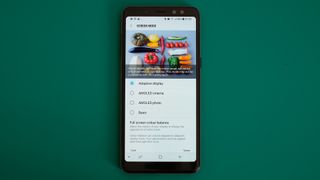
Just about every other element of the screen is great. It’s bright enough to make watching YouTube videos in bright sunlight enjoyable, contrast is superb and sharpness is very good.
The Samsung Galaxy A8 is much less pixel-dense than the Galaxy S9, with a 1080 x 2220 resolution. But you have to look very close to notice the slight pixel fizz visible on Samsung OLED displays that are not ridiculously high-res.
It’s a great screen. And when you watch 16:9 format videos you can choose whether to leave little black bars to the left and right of the image or zoom in slightly to fill the whole screen area.
- Thanks to Vodafone for providing us with a Samsung Galaxy A8 for review
Andrew is a freelance journalist and has been writing and editing for some of the UK's top tech and lifestyle publications including TrustedReviews, Stuff, T3, TechRadar, Lifehacker and others.
